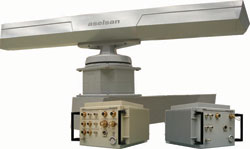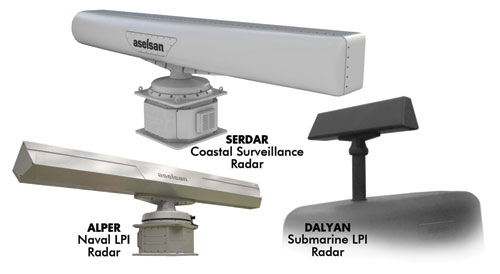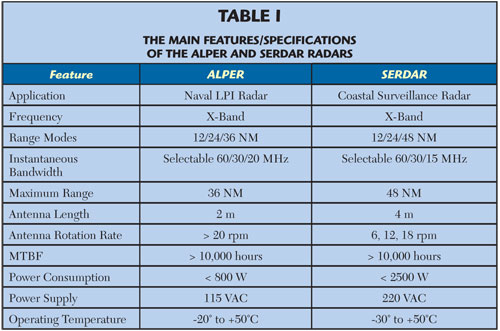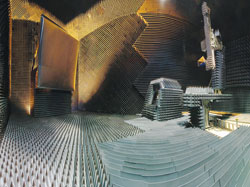
The tactical and technical capabilities of a radar system are determined mainly by the technical features of the associated antenna subsystem. Aselsan has developed a family of naval surveillance radars with individually developed, cutting-edge antennas tailored to provide excellent system performance, which has been verified in various field trials. The maritime surveillance radar family consists of ALPER, the Naval Low Probability of Intercept (LPI) radar for vessels; DALYAN, the subsurface counterpart of ALPER for submarines; and SERDAR, the coastal surveillance radar for critical coastal areas, shown in Figure 1.
The first to be launched was ALPER and systems have since been delivered to the Turkish Navy. The radar has excellent Electronic Counter-Countermeasures (ECCM) and LPI characteristics with an extensive detection range and a low level of emittance. SERDAR, which started factory acceptance testing in late 2011, exhibits similar characteristics but with a larger antenna, and it also eliminates blind zones in the coastal region being covered, regardless of terrain. Table 1 shows the main features/specifications of the ALPER and SERDAR radars. DALYAN, which will go into production in 2012, is essentially ALPER’s submarine counterpart with similar radar system features.

Fig. 1 Aselsan maritime surveillance radar family.

Slotted Waveguide Arrays
For all three maritime surveillance radar systems, slotted waveguide array (SWGA) antenna technology plays a key role in system performance. To meet combined LPI radar system and ECCM requirements, elaborate antenna designs are employed. Aselsan has developed two families of SWGA antennas for radar applications. One family consists of traveling-wave type planar phased arrays having fractional bandwidths up to 10 percent with electronically steerable beams and/or shaped beams, dual/linear polarization, high gain, ultra low side lobe levels and low cross polarization levels. These are mainly suitable for surveillance radar systems. The other family covers resonant planar phased arrays with exceptionally wide bandwidths, fixed monopulse beams, dual/linear/circular polarization, high gain, very low side lobe levels and low cross polarization levels. These are particularly suitable for reconnaissance and tracking radars.

Fig. 2 SWGA profiles.
Manufacturing and Testing

Fig. 3 Aselsan's compact test range facility.
Aselsan SWGA antennas employ inclined edge wall, broad wall and non-inclined edge wall designs with custom waveguide cross sections depending on the radar antenna pattern. Figure 2 shows SWGA profiles. High precision CNC milling, electro discharge machining (EDM), metal plating, aluminum vacuum brazing, torch brazing and metal bonding are the key in-house manufacturing processes that are specifically tailored for SWGA antenna manufacturing. Electromagnetic characteristics of the SWGA antennas are carefully measured using several in-house test chambers, such as anechoic planar near field testing, anechoic far field testing or anechoic compact testing (see Figure 3), depending on the size and type of the antenna. Environmental characteristics of the SWGA antennas are verified in environmental test facilities capable of performing system tests in accordance with MIL-STD-810F/G.
ALPER
The ALPER Naval LPI radar is designed and developed for navigation, surveillance, detection and tracking of surface and low altitude air targets in the littoral sea environment. It can be utilized with navigation radar, sharing its navigation control console, and can be linked to a combat management system (CMS). The main technical features of ALPER are a digital receiver, clutter suppression and detection algorithms, digital signal processing, a solid-state transmitter with adjustable output power and an SWGA array with high angular resolution and low sidelobe levels.
ALPER employs a 2 m long SWGA antenna operating at X-Band. The antenna has a horizontally polarized fan beam to meet angular resolution requirements and low side lobe and cross polarization levels in 3D space, within the whole operating frequency band to meet ECCM requirements. Antenna polarization can be factory set to circular polarization. The radar also has a low radar cross section (RCS) radome structure, making it suitable for integration on stealth military vessels.
DALYAN
DALYAN’s Line Replaceable Units are basically the same as those of ALPER, except for the antenna. DALYAN’s antenna is capable of withstanding 60 Bars of hydrostatic pressure, an essential feature for submarine radar, and it also has low RCS characteristics. A frequency selective surface radome with low insertion loss can also be employed to further reduce the RCS, without altering the antenna characteristics.
The antenna is 1 m long, employing a horizontally polarized cosec2 shaped beam tilted to the horizon with respect to the broadside of the array aperture in the elevation plane, directing maximum energy to the horizon. In order to improve the direction finding capability in the azimuth plane, a monopulse beamforming structure is employed.
SERDAR
SERDAR, the coastal surveillance radar that shares similar technical features with ALPER, is optimized for detection in the littoral environment. It can be directly linked to command and control (C2) systems. SERDAR’s capabilities mean that the antenna detection zone can start directly at the coast, free of any blind zones, regardless of the site geography. Whether the coast is mountainous or flat, the beam coverage can be optimized due to its adjustable beamformer.
SERDAR’s antenna is a 4 m long SWGA operating at X-Band. The antenna employs a horizontally polarized inverse cosec2 fan beam to meet angular resolution requirements and low sidelobe and cross polarization levels in 3D space across the whole operating frequency band. With the aid of an elevation beamformer, adjustable shaped beam synthesis can be achieved and antenna polarization can be factory set to circular polarization as well.
Aselsan’s maritime surveillance radar family, with incorporated customization features, provides exceptional solutions for coastal, marine and submarine surveillance.
Aselsan,
Ankara, Turkey
+90 312 592 10 00,
marketing@aselsan.com.tr,br /> www.aselsan.com.tr
